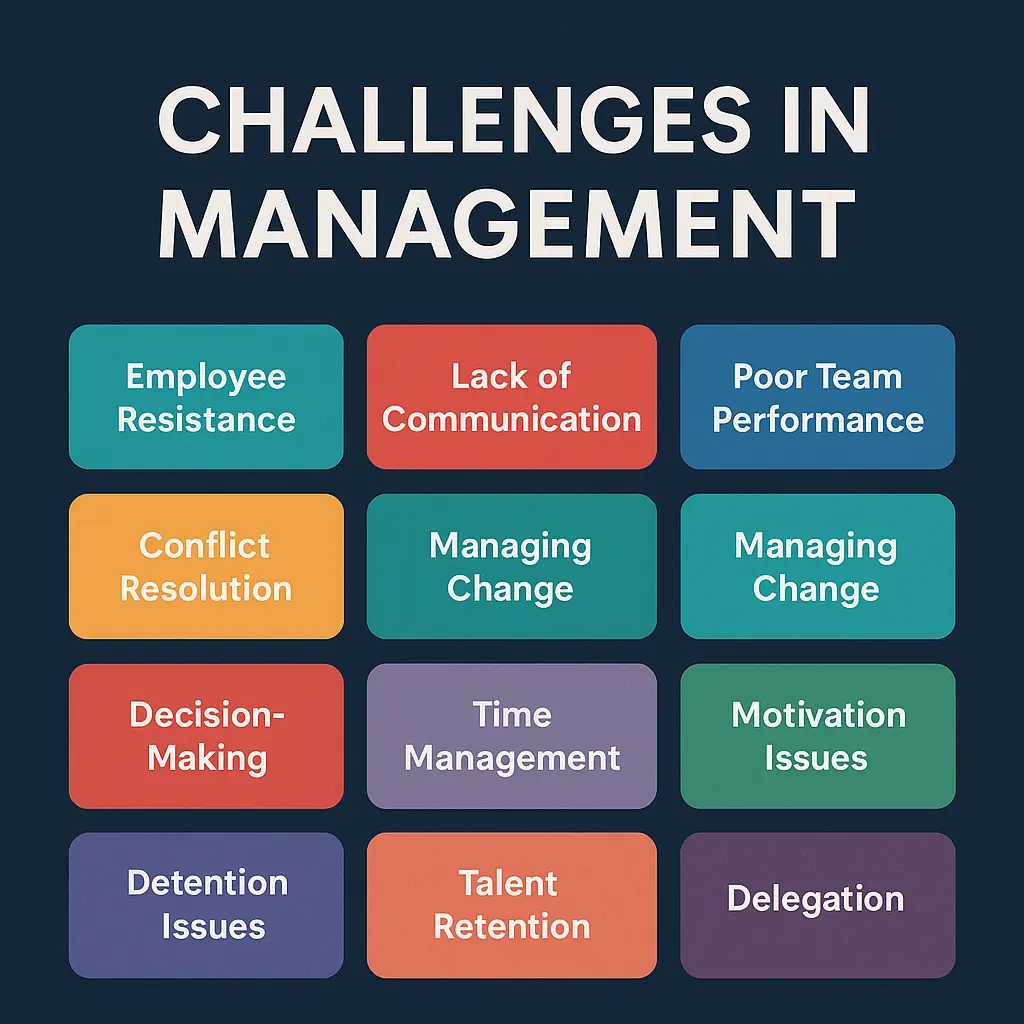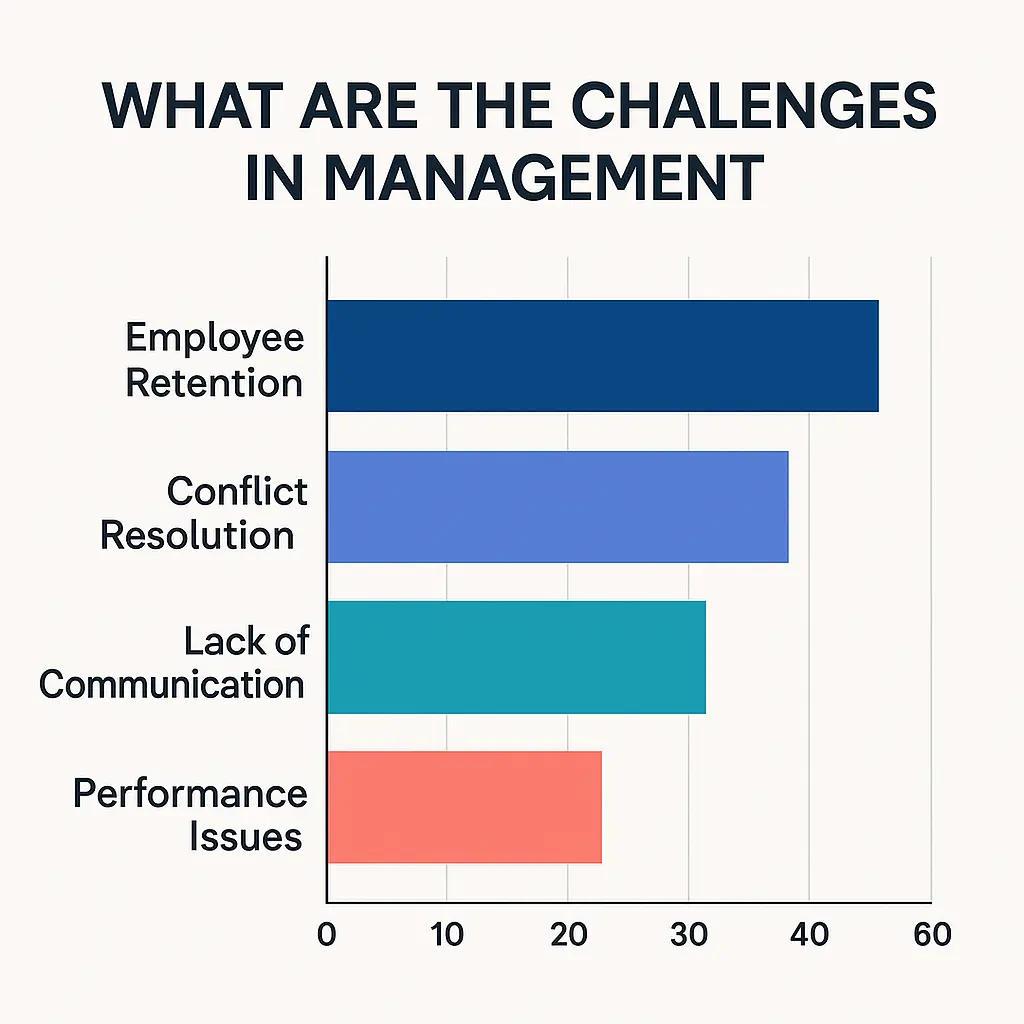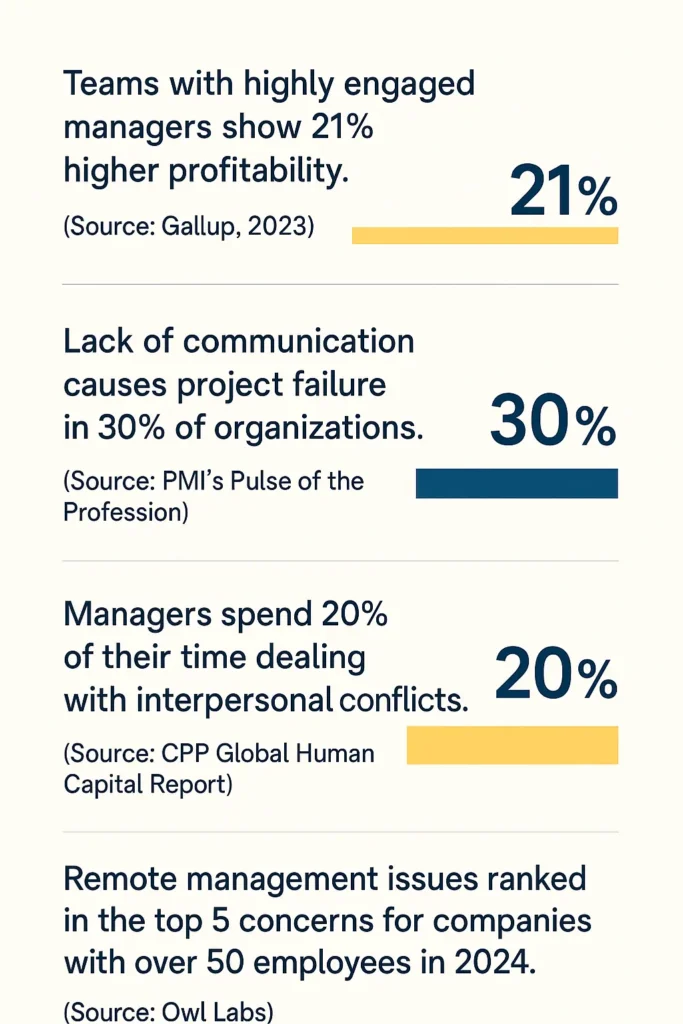What Are the Challenges in Management? 10 Real Problems

Being in charge isn’t just about calling the shots. It’s about juggling people, deadlines, decisions, and expectations—all at once. And when even one piece slips, the whole setup can start to wobble. Managers often walk a tightrope between team needs, business goals, and daily pressure. The truth is, management problems are part of the job, not the exception. What really counts is how you deal with them. So lets look at What Are the Challenges in Management?
|
Challenge |
Quick Tip That Helps |
|---|---|
|
Employee underperformance |
Weekly 1:1 check-ins with clear expectations |
|
Communication gaps |
Use written summaries after verbal instructions |
|
Task overload |
Prioritize based on deadlines, not urgency alone |
|
Conflict among team members |
Mediate early—don’t let silence grow resentments |
|
Budget or resource cuts |
Focus on essentials; renegotiate non-urgent tasks |
|
Remote team disengagement |
Use video when possible; celebrate small wins online |
|
Constant upper-level pressure |
Keep your team focused on what they can control |
Why Management Comes with Built-In Challenges
Every workplace, no matter the size, needs someone to keep things on track. That’s what managers do. But what makes the job hard isn’t just the workload—it’s the unpredictability. People don’t always agree, plans don’t always work, and priorities shift faster than expected.
Managers sit between upper leadership and frontline workers. They’re expected to hit targets, lead by example, and fix problems that don’t always have a perfect answer. On top of that, most teams include different personalities, work styles, and levels of motivation. Balancing all of this while staying productive? That’s no small task.
Even when a manager has the right skills, the environment can change quickly. New technology rolls in. Budgets shrink. Goals move. These shifts create friction, and it’s often the manager who feels it first.
In short: management challenges exist because people, systems, and goals don’t always line up perfectly. Recognizing this upfront makes it easier to prepare for what’s ahead, not just react to it.

Common Management Challenges Explained
Every manager faces hurdles that test patience, judgment, and leadership. No two days are the same, and the problems often come unannounced. From stretched deadlines to team friction, these problems can make the best managers feel off balance. But spotting these issues early and knowing how to respond is what keeps teams strong and goals on track.
1. Managing Employee Performance
It’s one thing to hire someone with a great resume. It’s another to help them stay consistent, improve where needed, and align with company goals. Performance management isn’t just about annual reviews—it’s a constant process.
Some employees start strong but slowly drift off course. Others never quite get up to speed. When this happens, it’s up to the manager to offer clear feedback, set practical goals, and support growth without making it personal.
Ignoring performance issues only makes things worse. But rushing in without a plan can lead to tension. The best managers find a middle ground: firm expectations, consistent check-ins, and open conversations.
2. Conflict Resolution Within Teams
Disagreements aren’t rare. People bring different views, values, and habits to the table. That’s natural. What matters is how those clashes are handled.
Sometimes tension is obvious—a raised voice in a meeting. Other times, it’s silent: missed deadlines, passive resistance, or gossip. In both cases, unresolved conflict can drain morale.
Managers need to step in early, listen without picking sides, and bring focus back to shared goals. Avoiding the problem only delays it. But resolving it with fairness and facts builds trust, not just peace.
3. Balancing Multiple Priorities
One minute you’re working on a budget. The next, HR wants updates, a client calls, and your team needs a decision. Sound familiar?
Juggling responsibilities without dropping the ball is a real test. It’s not just about doing more—it’s about knowing what matters most, and when. That means setting boundaries, saying no when needed, and helping the team do the same.
A scattered manager creates a scattered team. Clarity and structure can turn chaos into flow.
Fact Check
60% of managers say time management is their toughest ongoing challenge.
(Source: Gallup Workplace Study)
4. Adapting to Change
Change never waits for the perfect time. New software, fresh leadership, shifting markets—it all demands flexibility. But not everyone adjusts at the same pace.
Some employees resist even small shifts. Others get anxious or confused. The manager has to keep the team steady, even when they feel unsure themselves.
Being open about the reason for change, giving enough training, and setting short-term wins can make transitions smoother. It’s not about knowing all the answers—it’s about guiding the team through the unknown without panic.
5. Time and Task Overload
Many managers feel buried under their to-do list. Reports, meetings, emails, follow-ups—it never ends. Add in last-minute requests or a team member calling out sick, and it becomes overwhelming.
The real problem? Trying to do everything alone. Delegation is not a sign of weakness. It’s smart use of resources.
Managers who protect their time can actually give more to their team. And by teaching others to step up, they create future leaders—not just followers.

6. Communication Gaps
Clarity builds momentum. Confusion stalls it.
When instructions aren’t clear, or feedback loops break down, teams drift. It shows in missed deadlines, rework, or silent frustration. A single misunderstood sentence in a meeting can cost hours of productivity.
It’s not just what you say—it’s how and when you say it. Strong managers don’t assume. They confirm. They ask follow-ups. They simplify when needed. And they make space for others to ask without fear of sounding slow.
Clear communication is the glue that holds every other leadership skill together.
7. Employee Retention
Finding good people is hard. Keeping them? Even harder.
When team members leave too soon, it throws everything off balance—morale drops, workloads pile up, and recruitment starts all over again. But people don’t just leave jobs. They leave poor leadership, lack of growth, or feeling undervalued.
Retention isn’t about perks. It’s about purpose, trust, and opportunity. Managers who notice when someone’s losing interest and step in early often turn potential exits into long-term loyalty.
8. Limited Resources and Budget Cuts
Most managers work with tight margins. Maybe it’s fewer hands on deck. Maybe the budget shrinks but expectations grow. Maybe the team is asked to “do more with less”—again.
That pressure can stretch even high performers to their limit. And it forces managers into tough choices: What gets delayed? What’s cut entirely?
When resources drop, priorities must sharpen. Strong leaders are honest with their teams, transparent with stakeholders, and creative with solutions. Constraints don’t crush great teams—they sharpen them, if handled well.
9. Remote Team Management Problems
Managing people you don’t see in person brings new challenges. Are they working or distracted? Are they feeling disconnected? Is the team still functioning as a unit?
It’s not about hovering—it’s about trust, tools, and touchpoints.
The best remote managers set clear expectations, use video wisely, and check in like humans—not robots. They make space for both the work and the person behind the screen. Done well, remote teams can be even more focused than office-bound ones.
But without effort, distance grows in every way.
10. Pressure from Upper Management
You answer to your team—but also to the people above you. And sometimes, those two directions pull apart.
Leadership might want results faster. Or changes implemented immediately. Or costs slashed with no real plan. It puts managers in a tough spot: meet demands or protect the team?
The best managers learn to translate top-down goals into doable steps. They push back—professionally—when needed, and stand up for their team without creating division.
It’s a balancing act. And it takes thick skin, clear thinking, and solid relationships on both sides.
How Management Problems Affect Team Output
Leadership gaps don’t just stay at the top. They ripple outward.
When management problems pile up—unclear communication, low morale, shifting priorities—the team starts to slow down. Deadlines slip. Work quality dips. People mentally check out long before they hand in a resignation.
Productivity isn’t just about tools or systems. It reflects how supported people feel. A manager who listens, acts, and communicates clearly creates a space where good work happens naturally. But when leadership feels distant or chaotic, even the best team members pull back.
Over time, teams mimic their manager’s rhythm. If it’s steady, they perform. If it’s scattered, so are they.
Quick Fix vs Long-Term Management Solutions
Quick fixes look tempting. But they often hide the real issue.
Maybe it’s throwing in a bonus to fix morale. Or setting stricter deadlines to “increase accountability.” These might spark short-term action, but they rarely shift the root cause.
Long-term solutions take more work—but they stick. Real changes might include building better one-on-ones, revising workflows, or resetting expectations across the board.
It’s not about doing more. It’s about doing smarter.
Great managers zoom out, listen more, and build systems that don’t rely on constant patching. Because once people feel seen, heard, and guided—they show up with more energy than any quick fix could buy.

Final Thoughts: A Smarter Approach to Management Challenges
Management isn’t easy. It pulls you in ten directions on a good day and feels like a mess on the bad ones. But the true mark of a strong manager isn’t perfection—it’s progress. You won’t fix every problem overnight. You might stumble. But every time you tackle a conflict head-on or simplify a process, you’re building trust. You’re improving not just how the team works, but how they feel doing it. And that matters more than any title or deadline.
FAQs: What Are the Challenges in Management?

About the Author
Jonathan Savage is a leadership strategist who helps teams boost performance through clarity and structure. At SmartSuccessGuide.com, he shares proven frameworks for building focused, high-performing teams that deliver real results.






